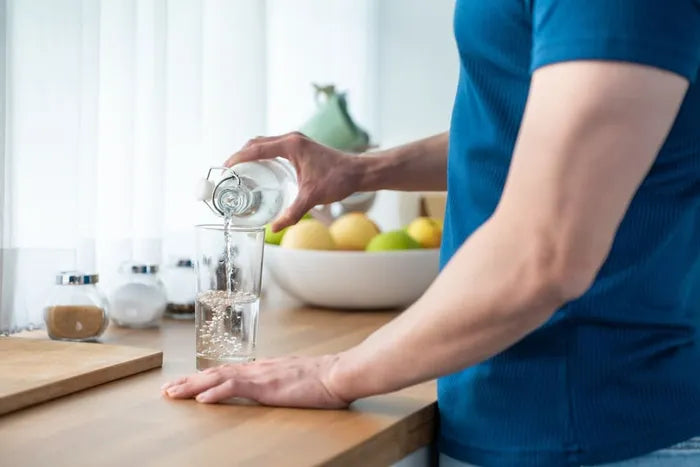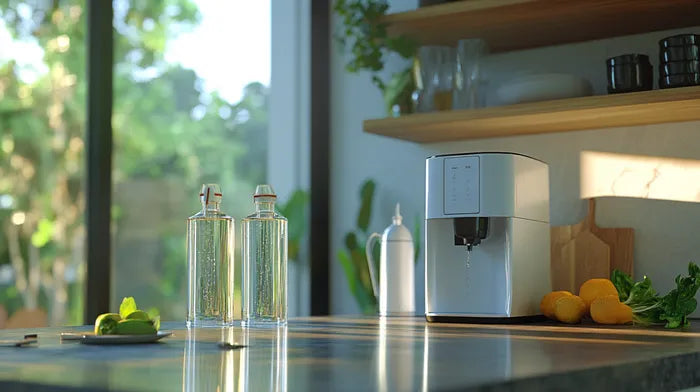How to Make Structured Water
Have you ever pondered how to make structured water from the comfort of your home? Dive into the science and learn how to structure water into its hexagonal form for enhanced benefits.
Updated February 4, 2025

Structured water, also known as hexagonal water, is water where the molecules form a hexagonal cluster. This form of water is believed to closely resemble the purity of natural spring water and glacier melts, boasting numerous health advantages.
We will guide you through the differences between two types of drinking water: structured water and unstructured water. We also explain how to make your own structured water at home.
Structured vs. Unstructured Water: Brief Overview
Unstructured water has a chemical formula of H2O, meaning two hydrogen atoms combine with one oxygen atom to make up a water molecule.
Structured water, on the other hand, has a chemical formula of H3O2, which means that three hydrogen atoms combine with two oxygen atoms to form something chemically different from “normal” water.
Denser, heavier, more viscous, and higher alkalinity levels. Balanced pH of 7 Water molecules possess a heightened electrical charge essential for cellular functionality.
Water molecules form irregular angles, hindering cellular absorption. They are also readily absorbed by cells due to their distinctive shape Water molecule size may impede effective cellular absorption and contribute to dehydration.
| Structured water | Unstructured water |
|---|---|
| Formula: H302 | Formula: H2O |
| Denser, heavier, more viscous, and has higher alkalinity levels | Has a balanced pH of 7 |
| Water molecules have a higher electrical charge vital for proper cell functioning | Water molecules form irregular angles making it more difficult for the cells to absorb |
| Water molecules are more easily absorbed in the cells due to their shape | Water molecule size may not be as effective for cell absorption and may cause dehydration |
Brace for Our Biggest Deals Yet:
4 Ways to Make Structured Water
Crafting structured water at home offers the advantage of ensuring access to this unique water type with significant health benefits. Below are four popular techniques for producing structured water:
1. The Crystal Method
Crystal and structured water are believed to be the same thing. Many people suggest that you can create structured water by charging it with crystals such as rose quartz, clear quartz, and amethyst, as they are water-safe. Other than that, you will need a glass jar and some clean water.
- Aligning with crystal water, structured water can be fashioned by infusing it with crystals such as rose quartz, clear quartz, and amethyst.
- Use a glass jar and high-quality water for this method. Begin by filling a jar with water and placing it in sunlight to charge through the crystals and solar energy.
- Introduce crystals into the jar and cover it, allowing several hours for water infusion.
- Optionally, remove the crystals or leave them within the water.
2. The Funnel Method
This method makes use of a vortex technique—which we will cover in more detail in the section below. You will need a funnel, a smooth stone or crystal that is not a perfect sphere, clean water, and marbles.
- Position a funnel atop a glass bottle. Insert the stone or crystal into the funnel, ensuring the hole remains unobstructed.
- Fill the funnel halfway with marbles.
- Pour water over the marbles to induce a vortex effect, structuring the water.
- Repeat this process for optimal results.
By using a water structuring device like MAYU Swirl, you can create structured water via the vortex technique easily at home and enjoy its advantages whenever you need it.
3. The Copper Method
It is believed that adding a copper plate to your water vessel not only removes impurities from the water but also restores it to its natural, structured state. You will need one clay or steel pot, clean water, a copper plate or sheet that is at least 1 mm thick (just over 1/32 inch), lemon, and salt.
- Cleanse the pot and fill it with water.
- Scrub the copper plate thoroughly with lemon and salt to eliminate oxidation marks.
- Rinse and dry the plate before placing it into the pot, covering it with a lid.
- Allow the water to sit for 6-8 hours or overnight for optimal effects.
- Retrieve the copper plate and utilize the structured water for consumption and culinary purposes
4. Infrared or UV Light Method
It is believed that structured water can be made using ultraviolet or infrared light. You will need a glass jar, clean water, and either a UV or infrared light.
- Fill your glass jar with clean water.
- Plug in your chosen light source and place it so that it’s shining on the glass jar or from above.
- Leave it on for 3-4 hours.
Can You Make Structured Water in a Blender?
Structured water is a product of vortexing, which energizes and enhances its properties. In nature, vortices serve as energy transformers and accumulators, restoring disturbed or contaminated substances to their original state.
A blender that creates a vortex effect could potentially restructure water, albeit water structuring devices offer a more reliable means of achieving vortex water benefits.
Water at Its Finest
Structured water is found naturally occurring in untouched and uncontaminated water sources. As there are many benefits to structured water, but it's not always easy to access it in nature, many people turn to making their own H3O2 water.
While there are various methods for making structured water at home, one of the easiest and most effective ways is to purchase a water structuring device. The MAYU Swirl is one such device that transforms any water into structured water quickly and effortlessly—giving you peace of mind that your water is truly in its finest state.













































